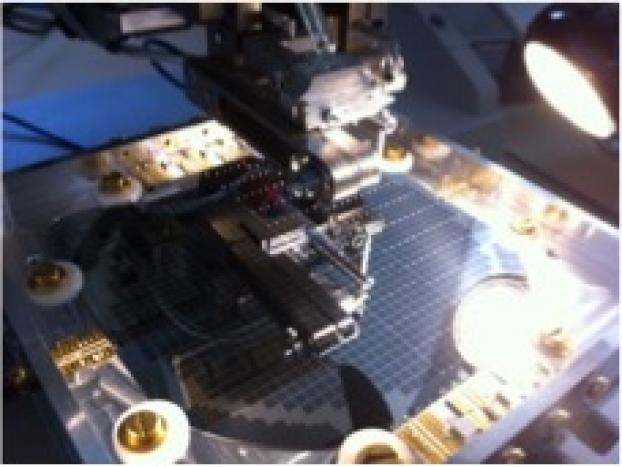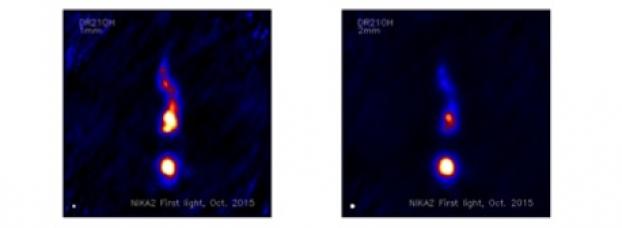Astronomy: NIKA2, a new instrument for the detection of millimetric waves
To detect a cold body, it is necessary that detection instruments are even colder, to avoid the thermal “noise” associated with the instrument. Based on the KID technology (Kinetic Inductance Detectors), superconducting detectors are kept at a very low temperature, the NIKA2 instrument has just been installed within the IRAM telescope (CNRS / MPG / IGN) located on Mount Pico Veleta (1), Spain. It will detect millimetric waves emitted by celestial bodies. More robust, cheaper and more sensitive than the existing millimetric detection instruments, this camera is the very first (2) to be equipped with KID technology for use in millimetric astronomy. The NIKA international consortium, coordinated by the Institut Néel (CNRS), hopes to be able to explore the star forming process in the nearby universe as well as in the distant universe by studying the emission of interstellar dust and the evolution of galaxy clusters via their interaction with the radiation coming from the Big Bang.

Since a large part of the matter in the universe is cold, it does not emit visible light but mainly infrared and millimeter waves, i.e. at wavelengths of the order of a millimeter. The use of optical telescopes therefore does not make it possible to study all the constituent elements of the Universe. Special radio telescopes are used to observe millimetre waves and in particular to study cold objects.
Based on a new technology, superconducting detectors that can be maintained at a very low temperature (0.15 Kelvin or -273 °C), the NIKA2 instrument is highly sensitive. It consists of numerous detectors forming three arrays, containing several thousand pixels. A single one of these pixels can distinguish, in one second of use, powers of the order of a few tens of atto-Watts (10-18 W), which would make it possible, for example, to measure the thermal emission of a rabbit placed at a distance of 1000 kilometers. It is the perturbation of the superconducting properties of millimetre-wave detectors that allows researchers to determine how much “light” has been emitted by astrophysical objects and thus to obtain an image of these objects.

With NIKA2, researchers will be able to explore a wide range of phenomena. Four projects in particular motivate the NIKA consortium. They concern the study of the evolution of clusters of galaxies, the production of detailed “maps” of nearby galaxies, and the study of interstellar dust and its polarization, to understand the formation of the dust and gas filaments involved in the birth of stars. This instrument will also make it possible to observe “empty fields “3 , to map the formation of stars obscured by dust and thus usually invisible to observations in the optical domain. The camera will be open, for a period of at least ten years, to the world scientific community, which will be invited to propose other subjects. The first observations are being made at the Pico Veleta Observatory. NIKA 2 is already, at this stage, showing performances that generate great hopes.
The NIKA consortium (New IRAM KID Arrays) brings together researchers, engineers and technicians from the Néel Institute (CNRS), IRAM, the Laboratory of Subatomic Physics and Cosmology (CNRS/University Grenoble Alpes/Grenoble INP), the Institute of Planetology and Astrophysics of Grenoble (CNRS/University Grenoble Alpes), and the Institute of Space Astrophysics (CNRS/University Paris-Sud), the Institute of Research in Astrophysics and Planetology (CNRS/Cnes/University Toulouse III – Paul Sabatier), the Institute of Astrophysics of Paris (CNRS/UPMC), the Laboratory of Astrophysics of Marseille (CNRS/Aix-Marseille University), the Astrophysics Instrumentation Modelling Laboratory (CNRS/University Paris Diderot/CEA), Paris Observatory, Cardiff University, ESO and the University of Arizona (ASU). NIKA2 was mainly funded by ANR, IRAM, LabEx FOCUS and an ERC contract from the European Community.
Note(s):
- The Institute for Millimetre Radio Astronomy (IRAM) was founded by the CNRS in France and the Max-Planck-Gesellschaft in Germany, joined by the Instituto Geográfico Nacional in Spain. This institute consists of its headquarters in Grenoble, France, a 30 m diameter radio telescope at Pico Veleta in Spain, and an interferometer of 7 antennas 15 m in diameter on the Plateau de Bure in the French Hautes-Alpes.
- The NIKA1 prototype, ten times smaller and based on the same technology, was installed on the same telescope between 2013 and 2015 to demonstrate the feasibility of the NIKA2 camera.
- Small portion of sky with no millimetre or sub-millimetre source identified.






